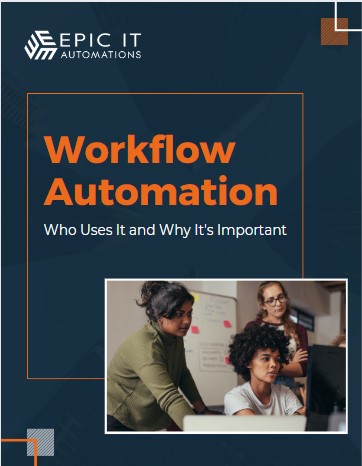First Impressions Can Make or Break You
Let me tell you a quick story. Years ago, I signed on with a new service provider. I was excited to get started, but after I paid the invoice, I didn’t hear a peep for days. No welcome email, no timeline, no next steps—just silence. I ended up following up myself to ask what was happening. Safe to say, that relationship didn’t last long.
That’s the power of first impressions.
Whether you’re a marketing agency, painting company, IT consultant, or landscaper, your clients are making snap judgments the minute they hit “yes” on your proposal. If things feel clunky, slow, or disorganized from day one, that initial excitement fades fast.
But here’s the good news: workflow automation can completely change that experience—for both you and your clients.
Why Onboarding Matters More Than You Think
Your Onboarding is Your First Real Test
Before your client sees your work, they see your process. If it’s smooth, they trust you more. If it’s messy, they doubt everything else you promise. In fact, according to Wyzowl, 86% of clients say they’re more likely to stay loyal to a business that offers a welcoming and efficient onboarding experience.
Small Gaps Create Big Frustration
- Ever forget to send a welcome packet?
- Manually emailing forms and forgetting follow-ups?
- Spreadsheets tracking tasks across multiple clients?
These little things are often invisible to you—but they’re very visible to your client. They notice when something’s late. Or confusing. Or just plain missing.
And most won’t say anything. They’ll smile, nod—and quietly take their business elsewhere next time.
4 Signs Your Client Onboarding Needs Help
1. You’re Chasing Paperwork
If your onboarding process still involves emailing PDFs, waiting on signatures, and reminding clients to fill out forms, you’re stuck in the past.
2. You Rely on Memory to Manage Clients
If you don’t have a checklist or automated workflow to guide each client through the same process, things will slip—guaranteed.
3. You Get the “What’s Next?” Question A Lot
When clients have to reach out to ask what the next step is, it signals a lack of clarity in your process.
4. Onboarding Feels Like a Headache
You should feel excited when you sign a new client—not stressed about all the things you might forget to do.
Enter Workflow Automation: Your New Best Friend
What Exactly is Workflow Automation?
Workflow automation is just a fancy way of saying: “Let’s get your tasks, forms, and follow-ups running like clockwork without you lifting a finger.”
Here’s how automation can completely transform the way you onboard clients:
✅ Consistent Process Every Time
Instead of reinventing the wheel with each new client, create a step-by-step automated sequence. You can:
- Trigger a welcome email the moment a contract is signed.
- Automatically assign internal tasks to your team.
- Send client forms, schedule calls, and deliver documents—all without you having to remember.
✅ Faster Response Times
Imagine a client signs on at 9 PM. Your automation kicks in instantly:
- They get a confirmation.
- They receive onboarding materials.
- A kickoff call is automatically scheduled.
You’ve impressed them before your morning coffee.
✅ Polished, Professional Experience
Automation makes you look bigger, more capable, and in control—even if you’re a solo operator.
✅ All-in-One Integration
Connect tools like:
- CRMs (e.g., HubSpot, Keap)
- Project Management (e.g., ClickUp, Trello)
- E-signature (e.g., PandaDoc, DocuSign)
- Calendar/Scheduling (e.g., Calendly)
So every piece of the puzzle talks to each other without you micromanaging.
Real Story: How One Home Services Business Saved 10+ Hours Weekly
We recently worked with a professional painting company. They were onboarding 3–5 new clients per week, and the owner was managing everything manually—emailing estimates, sending contracts, following up for deposits. It was chaos.
We implemented a simple automated onboarding system:
- Once a job was booked, the system sent all forms and welcome emails.
- The project manager was auto-assigned tasks.
- Weekly status updates were sent to the client automatically.
Within 30 days, the owner reported saving 10 hours per week and said, “I feel like I finally have time to grow the business instead of running in circles.”
Why This Matters More Than Ever
Clients have more options than ever. They’re researching competitors, checking reviews, and comparing processes.
Your onboarding experience is no longer a background task—it’s front and center in the sales process.
And here’s a secret:
You don’t have to hire more people to look like a bigger, better company. You just need better systems.
Automate to Impress—Starting Today
Here’s what happens when you automate onboarding:
- You look more professional.
- You feel more in control.
- You free up time to focus on growth, not grunt work.
And best of all? Your clients feel taken care of from the very first touchpoint.
Final Thought
You built your business to serve, to grow, and to succeed. Don’t let clunky onboarding trip you up at the starting line.
Your clients are judging you on day one. Make sure they’re impressed.
👉 Ready to see how simple this can be?
Book a free workflow call. We’ll discuss your onboarding and how to turn it into your biggest competitive advantage.
Contact: (608) 581-5100 or email us at info@epicitautomations.com. Learn more about our offerings by following us on Facebook, YouTube, and Instagram.











 Defining Business Systems
Defining Business Systems
